RESEARCH
Global comparative assessments of life expectancy: the impact of migration with reference to Australia
Evaluations comparatives internationales de lespérance de vie : influence de limmigration dans le cas de lAustralie
Evaluaciones comparativas mundiales de la esperanza de vida: impacto de la migración en el caso de Australia
Andrew Page; Stephen Begg; Richard Taylor; Alan D Lopez1
University of Queensland, School of Population Health, Public Health Building, Herston Road, Herston QLD 4006, Brisbane, Australia
ABSTRACT
OBJECTIVE: To investigate the effect of immigration on life expectancy in Australia for the period from 1981 to 2003, and to compare life expectancy of the Australian-born population with that of other countries in the Organisation for Economic Cooperation and Development (OECD).
METHODS: Standard life-table methods using age-specific all-cause mortality and population data from 1981 to 2003 were used to calculate life expectancy at birth (e0) for the total Australian population (including migrants) and for people born in Australia (excluding migrants). Mean differences in life expectancy for each sex were compared using paired t-tests. Rankings of life expectancy among OECD countries were reassessed, and rank changes measured using the Wilcoxon signed rank test.
FINDINGS: Life expectancy of males and females was significantly lower in the Australian-born group than in the total Australian population. During 1981 to 2003, there was a mean difference in life expectancy of 0.41 years (95% confidence interval, CI: 0.370.44; t17 = 27.0; P < 0.0001) in males and 0.29 years (95% CI: 0.260.31; t17 = 27.6; P < 0.0001) in females between the Australian-born and the total population. After excluding migrant groups, Australia no longer ranked among the top five OECD countries with the highest life expectancy in the two most recent years examined.
CONCLUSION: While Australia has one of the highest life expectancies in the industrialized world, this is partly attributable to immigration of populations with low rates of mortality. This effect needs to be considered in international comparative assessments of mortality levels.
RÉSUMÉ
OBJETIF: Etudier leffet de limmigration sur lespérance de vie en Australie sur la période 19812003 et comparer lespérance de vie pour les habitants de ce pays nés Australiens avec celle des habitants des autres pays de lOrganisation pour la coopération et le développement économiques (OCDE).
MÉTHODES: On a appliqué des méthodes classiques détude des courbes de survie à des données de mortalité par âge toutes causes confondues et à des données démographiques pour la période 19812003 afin de calculer lespérance de vie à la naissance (En) de la population australienne totale (y compris les immigrés) et de la population née Australienne (sans les immigrés). On a comparé les espérances de vie moyennes pour chaque sexe au moyen de tests t appariés. On a réévalué le classement par espérance de vie des pays de lOCDE et on a mesuré les changements de classement par le test de rangs de Wilcoxon.
RÉSULTATS: Les espérances de vie des hommes et des femmes appartenant à la fraction de la population née en Australie étaient significativement inférieures à celles des membres masculins et féminins de la population totale. Pour la période allant de 1981 à 2003, on a relevé une différence moyenne entre le groupe de population né en Australie et la population totale de 0,41 an [intervalle de confiance à 95 % (IC) : 0,370,44 ; t17 = 27,0, p < 0,0001] pour les hommes et de 0,29 an [intervalle de confiance à 95 % (IC) : 0,260,31 ; t17 = 27,6 ; p < 0,0001] pour les femmes. Après exclusion des groupes de population immigrée, lAustralie ne fait plus partie des cinq premiers pays de lOCDE les mieux placés pour lespérance de vie pour les deux années étudiées les plus récentes.
CONCLUSION: Si lespérance de vie calculée pour lAustralie est parmi les plus élevées du monde industrialisé, cette situation est en partie imputable à la présence de populations immigrées à faible taux de mortalité. Cet effet doit être pris en compte dans les évaluations comparatives à léchelle internationale des taux de mortalité.
RESUMEN
OBJETIVO: Investigar el efecto de la inmigración en la esperanza de vida en Australia durante el periodo de 1981 a 2003, y comparar la esperanza de vida de la población nacida en Australia con la de otros países de la Organización de Cooperación y Desarrollo Económicos (OCDE).
MÉTODOS: Se emplearon métodos estándar de las tablas de vida en los que se usaron la mortalidad por todas las causas por edades y datos demográficos de 1981 a 2003 para calcular la esperanza de vida al nacer (e0) en la población australiana global (migrantes incluidos) y en la población nacida en Australia (migrantes excluidos). Las diferencias medias en la esperanza de vida para cada sexo se compararon mediante pruebas t pareadas. Se reevaluó la esperanza de vida en los países de la OCDE, reordenándolos por ese criterio, y se aplicó la prueba de ordenamiento con signo de Wilcoxon para medir los cambios de rango.
RESULTADOS: La esperanza de vida de hombres y mujeres fue significativamente inferior en el grupo nacido en Australia que en la población australiana global. Entre 1981 y 2003, se detectó una diferencia media de la esperanza de vida de 0,41 años (intervalo de confianza (IC) del 95%: 0,370,44; t17 = 27,0; P < 0,0001) en los hombres y de 0,29 años (IC95%: 0,260,31; t17 = 27,6; P < 0,0001) en las mujeres entre los nacidos en Australia y la población total. Tras excluir a los grupos migrantes, Australia dejó de figurar entre los cinco países de la OCDE con mayor esperanza de vida en los dos años más recientes examinados.
CONCLUSIÓN: Aunque Australia presenta una de las esperanzas de vida más altas del mundo industrializado, ello se debe en parte a la inmigración de poblaciones con tasas bajas de mortalidad. Este efecto debería tenerse en cuenta en las evaluaciones comparativas internacionales de la mortalidad.
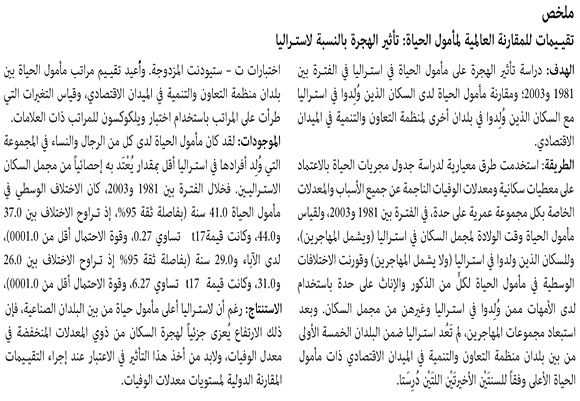
Introduction
In recent international league tables of life expectancy in countries that are members of the Organisation for Economic Cooperation and Development (OECD), Australia is ranked among the top five, behind countries such as Japan, Iceland and Sweden.1,2 Life expectancy in Australia has improved over time in absolute terms, and also relative to other nations.2
Routinely reported estimates of Australian life expectancy generally refer to the total Australian population. This obscures the effect of widespread immigration to Australia predominantly from southern and eastern Europe after World War II3 and from south-east Asia in the latter part of the 20th century (Figs. 1 and 2) that has occurred simultaneously with periods of increasing life expectancy. The net effect of different life expectancies in the country of origin of migrant groups on total Australian life expectancy is not clear. Migrants from better material circumstances or with higher levels of education than others may be more likely to immigrate, and to be accepted into Australia, the net effect being to increase overall Australian life expectancy due to the so-called "healthy migrant" effect.46 It is also conceivable that lifestyle factors shaped by the cultural mores of a given country of birth, such as diet,7,8 are retained by immigrants and, to a lesser extent, by subsequent migrant generations;9 these may influence the overall life expectancy of the Australian population.

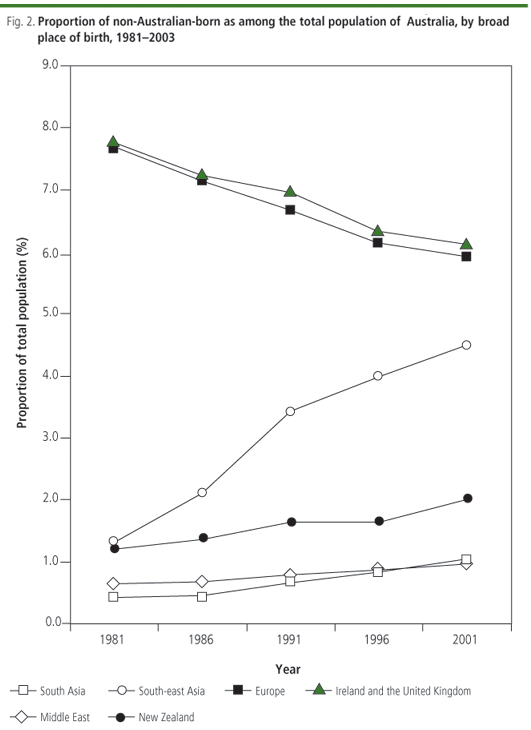
This study investigated Australian life expectancy according to migrant status for the latter part of the 20th century, to determine the extent to which the selection effects described above may be evident in overall estimates of life expectancy in Australia. Retrospective cross-national comparisons of life expectancy for all OECD countries and for Australian-born and non-Australian-born groups were also conducted to establish how relative improvements in Australian life expectancy rankings change according to migrant composition.
Methods
Data
Data on age-specific all-cause mortality stratified by migrant status (Australian-born or non-Australian-born) and sex were obtained from the Australian Bureau of Statistics for 1981 and 1986 to 2003. Age groups were defined for infants < 1 year, 14 years, and then in 5-year age groups to > 90 years. Corresponding denominator populations for each year were obtained from the Australian Bureau of Statistics based on estimated resident populations, similarly stratified by migrant status. The population data on migrant status for the period from 1981 to 1986 were determined by the Australian Bureau of Statistics to be of insufficient quality for analysis, and therefore these years were excluded. Data from 1981, an Australian census year, were retained for international comparisons with OECD estimates.
Age-specific all-cause mortality data and corresponding population data for all OECD nations were obtained from WHO. Comparative data were obtained for approximate 5-year age intervals for the years 1981, 1986, 1990, 1995 and 2000. Mortality data for Belgium were not available from WHO after 1997. Enumeration of mortality data in the Republic of Korea and Turkey suggest that death registration is less than 90% complete; these data were therefore not of a comparable standard to those from other nations and were excluded from the analysis.10,11
Analysis
Australian life expectancy at birth (e0) for each study year (1981, 19862003), by migrant status and sex, and life expectancy at birth for OECD nations was calculated using standard life-table methods, as described elsewhere,12 using the Coale-Guo extension for age groups > 80 years.13 The 95% confidence interval (CI) for the estimate of e0 was derived using the Chiang method.14 There is selection bias in the migrant group (the "healthy migrant" effect). Migrant life expectancy is not a "true" life expectancy at birth, but rather life expectancy after the date of first registration, and therefore will include only those children who reached Australia; perinatal and other childhood mortality are excluded in this group.
Age-specific mortality rates per 1000 and age-specific mortality rate ratios stratified by migrant status and sex were also considered for each census year 1981, 1986, 1991, 1996 and 2001 (years when country-of-birth data were directly recorded through the Australian census). Age-specific analyses were conducted to investigate which age groups might account for differential mortality rates by migrant status over time.
Mean differences in life expectancy by migrant status over the study period were compared using paired t-tests.15 Changes in the ranking of life expectancy by migrant status in Australia compared with life expectancies in OECD nations were investigated using the non-parametric Wilcoxon signed rank sum test.15 Rank differences in life expectancy between the Australian-born and the total Australian population were calculated to determine whether the number of negative changes in ranking for the Australian-born group (compared with the total Australian population) were greater than that which would occur by chance alone.
Results
Life expectancy was significantly lower in the Australian-born group (excluding migrants) than in the total Australian population, for both males and females (Fig. 3). For the entire study period, there was a mean difference of 0.41 years (95% CI, 0.370.44; t17 = 27.0; P < 0.0001) for male life expectancy and 0.29 years (95% CI, 0.260.31; t17 = 27.6; P < 0.0001) for female life expectancy between the Australian-born and the total population. Differences between the Australian-born group and the total Australian population were slightly larger in the most recent quinquennium for females, although the magnitude of the difference was not statistically different from that observed in earlier years.

The substantial and continuing decline in rates of mortality at all ages in Australia since 1981 is clear from Table 1. Age-specific mortality rates were higher in the Australian-born group than in the non-Australian-born group (Table 1). The relative excess mortality among the Australian-born was initially greatest among those aged 4059 years, but this excess has progressively declined over time. Conversely, age-specific mortality rate ratios have increased (mortality rates for the Australian-born relative to the non-Australian born) in older age groups (> 60 years) for males and females since 1981 (Figs. 4 and 5). Mortality rates for males and females among the Australian-born also increased (relative to the non-Australian born) in younger age groups (those aged 519 and 2039 years) peaking in 1991, after which mortality rate ratios at these ages have generally declined. Mortality rates for those aged 04 years (not shown) were based on small underlying case numbers, especially for migrants, and showed large stochastic variation over time. For those born in Australia, mortality rates for males and females aged 04 years (not shown) were of a greater magnitude than for other age groups, and decreased over time relative to the non-Australian born.
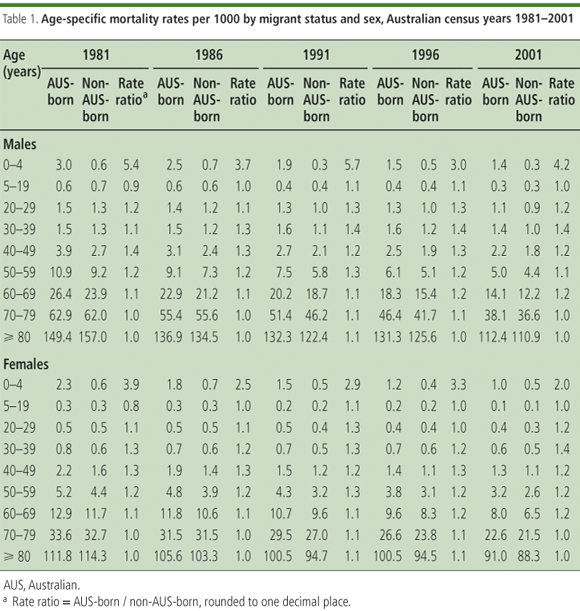
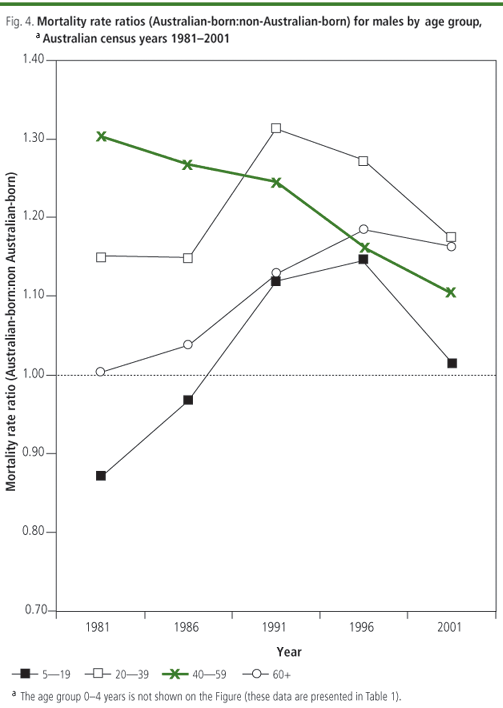
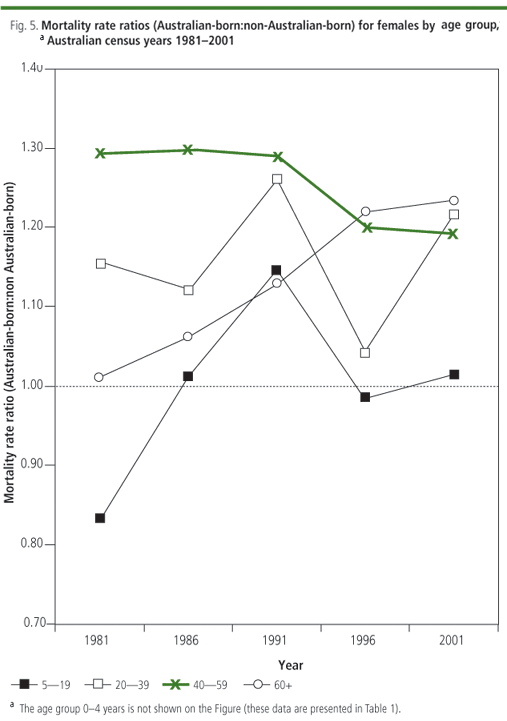
In a comparison of OECD rankings of life expectancy for the study period, when migrant groups were excluded from calculations of Australian life expectancy, Australia moved down an average of two ranks for males (Table 2, available at: http://www.who.int/bulletin) and females (Table 3, available at: http://www.who.int/bulletin), and dropped out of the top five OECD member countries in the most recent years examined (1995, 2000). This change in ranking was significant for males (T- = 0; n16 = 0; P < 0.05) and females (T- = 0; n16 = 0; P < 0.05). In none of the years selected was the Australian-born group ranked higher than the total Australian population (for both sexes).
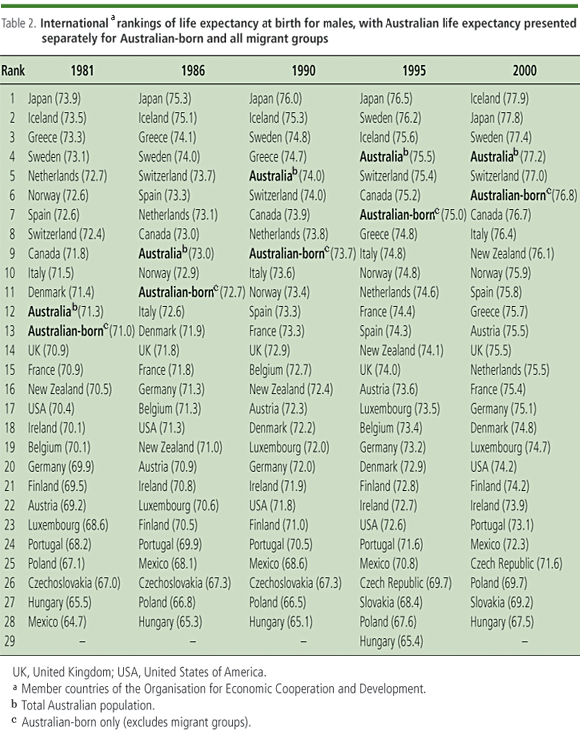
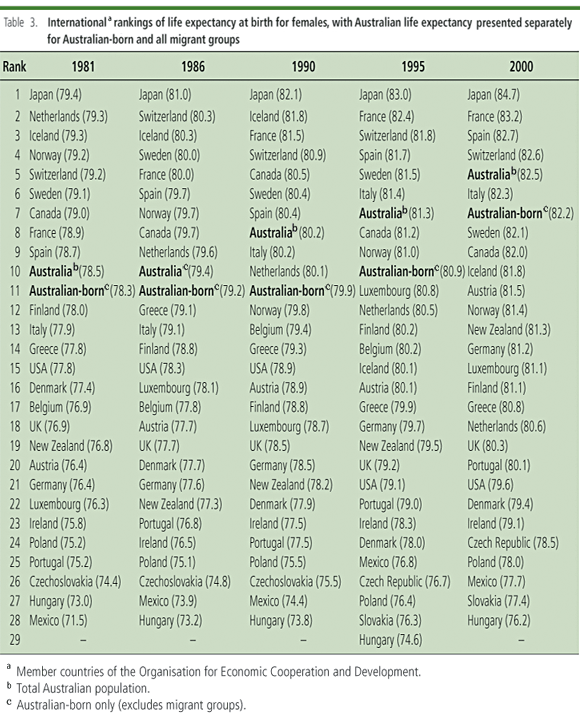
Discussion
There have been marked changes in the migrant composition of the Australian population from 1950 to 2000. These changes began in the immediate post-World War II period with a significant influx of English, Irish and southern and eastern European migrants,3 and continued in subsequent decades (from the 1970s) with increased migration from south-east Asia (Figs. 1 and 2).
After World War II, the Australian government implemented a large-scale immigration campaign with a target to increase the Australian population by 1% per year and to increase the availability of labour in the post-war boom.3,16 A significant proportion of migrants during this period also arrived in Australia under humanitarian programmes as refugees.3,16 In the 1950s and 1960s, a two-tiered immigration model developed under the so-called "White Australia" policy, whereby migrants from an English-speaking background (predominantly Ireland and the United Kingdom) were given "assisted passage" to Australia, while those from a non-English-speaking background were required to use their own resources and make their own arrangements.16
This immigration strategy changed in the 1970s, a period of international recession and major economic restructuring of market capitalism.16 This period saw increased globalization and deregulation of the Australian economy, and as a consequence increased demand for skilled labour (predominantly in manufacturing industries). A nondiscriminatory immigration policy implemented during this time increased the number of migrants from non-English-speaking backgrounds, in particular Vietnamese refugees and migrants from other parts of south-east Asia.16
Migrants now currently constitute approximately 23% of the Australian population.17 It is plausible that the delayed effects of migration in the 1950s and 1960s with the ageing of migrants, and continuing migration in the latter part of the 20th century, have had an impact on current health status and mortality patterns in Australia. In previous studies of migrant mortality in Australia, rates of mortality attributable to specific causes have been found to be lower in several migrant groups, and similar to those in the country of origin.1825 The effect of a younger age profile of migrants in the post-World War II period has also been posited as an important factor in the determination of subsequent population structure and mortality levels,26,27 although other studies have suggested that the age profile of migrants has had a negligible effect on overall Australian life expectancy.28
The findings of the present study indicate that the increase in Australian life expectancy between 1981 and 2003 can be partly attributed to the effects of migration. Overall, life expectancy for males differed by 0.4 years and for females by 0.3 years between the Australian-born and the total Australian population. When life expectancies for the Australian-born and for the total Australian population were compared separately with rankings of life expectancies in other OECD nations, the ranking of Australia fell by an average of two ranks for males and females between 1981 and 2000, and Australia dropped out of the top five OECD countries in the most recent period examined. The effect of migration on Australian life expectancy is not trivial when compared with countries, such as Japan, that have low levels of migration.
Age-specific mortality rate ratios indicate that mortality rates in the Australian-born aged 4059 years decreased over the study period more rapidly than in the non-Australian born. This in turn may be attributable to a decrease in the incidence of noncommunicable disease, in particular coronary heart disease, in the Australian-born over recent decades.29 In older age groups (> 60 years), the increase in mortality in the Australian-born relative to the non-Australian born for both males and females may reflect the greater exposure, on average, of older Australians to risks such as tobacco30 compared with the migrant group.
There is potential for enumeration bias in mortality data when comparing data from Australia with data from other countries. Although all OECD nations have standard, centralized enumeration of vital statistics, differences in process may result in under-enumeration of mortality; this may have a differential impact upon calculations of life expectancy. Enumeration bias in this sense is unlikely to be an important factor in the interpretation of our findings, as the main focus of the study is the relative differences in Australian mortality when including and excluding migrant groups, compared with other nations. There may well be cross-national differences in enumeration methods; however, to the extent that such differences have remained constant, the interpretation of relative changes in Australian life expectancy for the Australian-born and total Australian population remains valid. We have also used a standardized method for calculating cross-national life expectancies using mortality data from WHO for all OECD countries, which avoids the influence of differences in statistical methods used to calculate rankings of cross-national life expectancies.12
It is also important to note that neither migrant nor non-migrant groups considered in this study are homogeneous. It is likely that there are important mortality differentials by other demographic, socioeconomic and geographic strata within migrant and Australian-born groups. For example, the Australian-born group comprises indigenous Australians, who have a significantly lower life expectancy than the total Australian population.31 The high mortality rate in this group would reduce the differences observed between migrants and non-migrants. However, the effect of mortality among indigenous Australians on the relative excess in mortality rate ratios in migrants compared with non-migrants is not substantial, comprising a reduction of approximately 4% for all ages between 1996 and 2001, owing to the small indigenous population (approximately 2% of the Australian population).
The implications of our findings are that increases in the number of migrants over the latter part of the 20th century as a proportion of the total Australian population have resulted in an even greater increase in overall life expectancy than would otherwise have been the case. This effect is not trivial and has previously been obscured, as it is total Australian life expectancy that is routinely reported. Life expectancy in the Australian-born has also increased over this period, associated with a range of factors. These include the success of health promotion campaigns on population risk factors relating to diet and alcohol and tobacco consumption,2,32 improvements in health services and medical treatment, and early diagnosis of disease through population and opportunistic screening.2
However, there are also factors specific to migrant status that afford additional benefits to the overall life expectancy of the Australian population. "Selection" effects can lead to differential life expectancies in migrant groups compared with non-migrant groups. Those from better material circumstances or with higher levels of education than others may be more likely to be allowed to immigrate to Australia. The net effect is to increase overall Australian life expectancy owing to the healthy migrant effect.46 Migrants are also predominantly from younger age groups, with the most recent routinely available migration data (19962002) indicating that approximately 29% are aged 2534 years and approximately 25% are aged 014 years.17 There is also the effect of unofficial remigration of unhealthy individuals to their country of birth for treatment, or in extreme cases to die, resulting in an underestimation of migrant mortality.4 The extent of remigration of unhealthy individuals is not possible to quantify in the Australian context. The findings of the present study are consistent with those of studies showing higher life expectancies for migrants in the United States of America (USA)33 and other studies showing lower mortality rates for migrants in, for example, Asian, Pacific Islander and Hispanic migrants in the USA,33,34 migrants from the Republic of Korea in Japan,35 and southern European, Moroccan and Turkish migrants in Belgium.36
It is also conceivable that lifestyle factors such as diet that are shaped by the cultural mores of a given country of birth and retained by immigrants and, to a lesser extent, subsequent migrant generations9,37 may influence the overall life expectancy of the Australian population. In Australia, a large proportion of migrants have come from southern Europe and south-east Asia.3 The efficacy of the "Mediterranean diet" and Asian equivalents on common risk factors for high-prevalence diseases (such as cardiovascular disease and some cancers) has been noted previously.7,8 Such dietary factors include abundant consumption of vegetables, fruit and whole grains and lower intake of dairy foods,7 and are more likely to be evident in sections of the southern European and south-east Asian migrant populations in Australia.25,37 However, acculturation also has effects on health status over time, with previous studies in Australia38 and the USA34 indicating that health status can decrease with the length of stay and in second-generation migrants.
This study has shown that life expectancy in Australia increased substantially in the latter 20th century, and that this can partly be attributed to immigration of populations with a low mortality during the immediate post-World War II period and subsequent decades. Continued increases in Australian life expectancy, particularly in recent years, suggest that ongoing migration will continue to have a beneficial effect upon future life expectancy in Australia. Comparisons of life expectancy that include host migrant countries such as Australia, Canada, New Zealand and the USA are likely to exaggerate the population-level benefit of health policies and programmes compared with countries such as Japan, where international migration is trivial. 
Competing interests: None declared.
References
1. Working together for health: the world health report. Geneva: WHO; 2006.
2. Australias health, 2006. Canberra: Australian Institute of Health and Welfare; 2006.
3. Jupp J. Two hundred years of immigration. In: Reid J, Trompf P, eds.: The health of immigrant Australia: a social perspective. Sydney: Harcourt Brace Jovanovich; 1990:1-38.
4. Uitenbroek DG, Verhoeff AP. Life expectancy and mortality differences between migrant groups living in Amsterdam, the Netherlands. Soc Sci Med 2002;54:1379-88.
5. Marmot MG, Adelstein AM, Bulusu L. Lessons from the study of immigrant mortality. Lancet 1984;1:1455-7.
6. Feinleib M. Invited commentary on "Health effects of Westernization and migration among Chamorros." Am J Epidemiol 1995;142:671-2.
7. Kushi LH, Lenart EB, Willett WC. Health implications of Mediterranean diets in light of contemporary knowledge. 1. Plant foods and dairy products. Am J Clin Nutr 1995;61:1407S-15S.
8. Gjonca A, Bobak M. Albanian paradox, another example of protective effect of Mediterranean lifestyle? Lancet 1997;350:1815-7.
9. Razum O, Zeeb H, Akgun HS, Yilmaz S. Low overall mortality of Turkish residents in Germany persists and extends into a second generation: merely a healthy migrant effect? Trop Med Int Health 1998;3:297-303.
10. Akgun S, Rao C, Yardim N, Bessara B, Aydin O, Mollahaliloglu S et al. Estimating mortality and causes of death in Turkey: methods, results and policy implications. Eur J Public Health 2007; April 2 [Internet publication ahead of print].
11. Mathers CD, Fat DM, Inoue M, Rao C, Lopez AD. Counting the dead and what they died from: an assessment of the global status of cause of death data. Bull World Health Organ 2005;83:171-7.
12. Lopez AD, Ahmad OB, Guillot M, Ferguson BD, Salomon JA, Murray CJL, et al. World mortality in 2000: life tables for 191 countries. Geneva: WHO; 2002.
13. Coale A, Guo G. Revised regional model life tables at very low levels of mortality. Popul Index 1989;55:613-43.
14. Chiang CL. Life table and mortality analysis. Geneva: WHO; 1976.
15. Armitage P, Berry G, Matthews JNS. Statistical methods in medical research, 4th Edition. Oxford: Blackwell Science Ltd; 2002.
16. Collins J. The changing political economy of Australian immigration. Tijdschr Econ Soc Geogr 2006;97:7-16.
17. Migration, Australia, 200203. Canberra: Australian Bureau of Statistics; 2004.
18. Young CM. Migration and mortality: the experience of birthplace groups in Australia. Int Migr Rev 1987;21:531-54.
19. Bennett SA. Inequalities in risk factors and cardiovascular mortality among Australias immigrants. Aust J Public Health 1993;17:251-61.
20. Kliewer EV, Smith KR. Breast cancer mortality among immigrants in Australia and Canada. J Natl Cancer Inst 1995;87:1154-61.
21. Kliewer EV, Smith KR. Ovarian cancer mortality among immigrants in Australia and Canada. Cancer Epidemiol Biomarkers Prev 1995;4:453-8.
22. Burvill PW. Migrant suicide rates in Australia and in country of birth. Psychol Med 1998;28:201-8.
23. McCredie M, Williams S, Coates M. Cancer mortality in East and Southeast Asian migrants to New South Wales, Australia, 19751995. Br J Cancer 1999;79:1277-82.
24. McCredie M, Williams S, Coates M. Cancer mortality in migrants from the British Isles and continental Europe to New South Wales, Australia, 19751995. Int J Cancer 1999;83:179-85.
25. Kouris-Blazos A. Morbidity mortality paradox of first-generation Greek Australians. Asia Pac J Clin Nutr 2002;11:S569-75.
26. Saunders P. Dawning of a new age? The extent, causes and consequences of ageing in Australia. Discussion Paper 75. Sydney: Social Policy Research Centre, University of New South Wales; 1996.
27. Withers G. A younger Australia? Discussion Paper 63. Canberra: Public Policy Program, Australian National University; 1999.
28. Kippen R, McDonald P. Australias population in 2000: the way we are and the ways we might have been. People Place 2000;8:10-7.
29. Taylor R, Dobson A, Mirzaei M. Contribution of changes in risk factors to the decline of coronary heart disease mortality in Australia over three decades. Eur J Cardiovasc Prev Rehabil 2006;13:760-8.
30. Peto R, Lopez AD, Boreham J, Thun M, Heath C Jr. Mortality from tobacco in developed countries: indirect estimation from national vital statistics. Lancet 1992;339:1268-78.
31. Hill K, Barker B, Vos T. Excess indigenous mortality: are indigenous Australians more severely disadvantaged than other indigenous populations? Int J Epidemiol 2007; April 3 [Internet publication ahead of print].
32. Taylor R, Lewis M, Powles J. The Australian mortality decline: cause-specific mortality 19071990. Aust N Z J Public Health 1998;22:37-44.
33. Singh GK, Miller BA. Health, life expectancy, and mortality patterns among immigrant populations in the United States. Can J Public Health 2004; 95:I14-21.
34. Frisbie WP, Cho YT, Hummer RA. Immigration and the health of Asian and Pacific Islander adults in the United States. Am J Epidemiol 2001;153:372-80.
35. Kim Y. Recent life expectancy of Koreans in Japan, 1980 and 1985. Ingu Pogon Nonjip 1987;7:39-55.
36. Deboosere P, Gadeyne S. Adult migrant mortality advantage in Belgium: evidence using census and register data. Population (Paris) 2005;60:765-811.
37. Webb K, Manderson L. Food habits and their influence on health. In: Reid J, Trompf P, eds. The health of immigrant Australia: a social perspective. Sydney: Harcourt Brace Jovanovich; 1990.
38. Powles J, Gifford S. How healthy are Australias immigrants? In: Reid J, Trompf P, eds. The health of immigrant Australia: a social perspective. Sydney: Harcourt Brace Jovanovich; 1990.
(Submitted: 29 August 2006 Final revised version received: 21 November 2006 Accepted: 23 November 2006)
1 Correspondence to Alan D Lopez (e-mail: a.lopez@sph.uq.edu.au).
